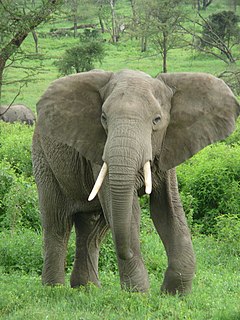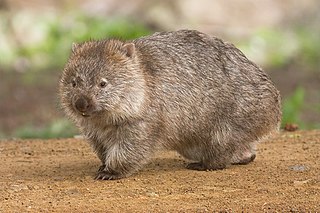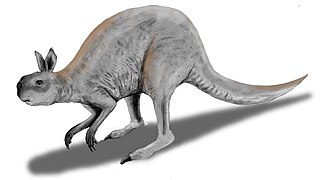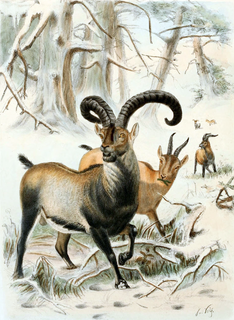
Diprotodon is an extinct genus of large marsupials native to Australia from the Pleistocene epoch. It is considered one of Australia's core species of "megafauna", which ranged throughout the continent during the Pleistocene. The genus is currently considered monotypic, containing only Diprotodon optatum, the largest known marsupial to have ever existed. The word diprotodon is constructed from the Ancient Greek words for 'two forward teeth'. Diprotodon existed from about 1.6 million years ago until extinction some 44,000 years ago.

The Holocene extinction, otherwise referred to as the sixth mass extinction or Anthropocene extinction, is an ongoing extinction event of species during the present Holocene epoch as a result of human activity. The included extinctions span numerous families of bacteria, fungi, plants and animals, including mammals, birds, reptiles, amphibians, fish and invertebrates. With widespread degradation of highly biodiverse habitats such as coral reefs and rainforests, as well as other areas, the vast majority of these extinctions are thought to be undocumented, as the species are undiscovered at the time of their extinction, or no one has yet discovered their extinction. The current rate of extinction of species is estimated at 100 to 1,000 times higher than natural background extinction rates.

In terrestrial zoology, the megafauna comprises the large or giant animals of an area, habitat, or geological period, extinct and/or extant. The most common thresholds used are weight over 45 kilograms (100 lb) or over a tonne, 1,000 kilograms (2,205 lb). The first of these include many species not popularly thought of as overly large, and being the only few large animals left in a given range/area, such as white-tailed deer, thomson's gazelle, and red kangaroo. In practice, the most common usage encountered in academic and popular writing describes land mammals roughly larger than a human that are not (solely) domesticated. The term is especially associated with the Pleistocene megafauna – the land animals often larger than modern counterparts considered archetypical of the last ice age, such as mammoths, the majority of which in northern Eurasia, the Americas and Australia became extinct within the last forty thousand years. Among living animals, the term megafauna is most commonly used for the largest extant terrestrial mammals, which includes elephants, giraffes, hippopotamuses, rhinoceroses, and large bovines. Of these five categories of large herbivores, only bovines are presently found outside of Africa and southern Asia, but all the others were formerly more wide-ranging, with their ranges and populations continually shrinking and decreasing over time. Wild equines are another example of megafauna, but their current ranges are largely restricted to the old world, specifically Africa and Asia. Megafaunal species may be categorized according to their dietary type: megaherbivores, megacarnivores, and, more rarely, megaomnivores. Megafauna are also categorized by the order of animals that they belong to, which are mammals, birds, reptiles, amphibians, fish, and invertebrates.

A mastodon is any proboscidean belonging to the extinct genus Mammut that inhabited North and Central America during the late Miocene or late Pliocene up to their extinction at the end of the Pleistocene 10,000 to 11,000 years ago. Mastodons lived in herds and were predominantly forest-dwelling animals that lived on a mixed diet obtained by browsing and grazing, somewhat similar to their distant relatives, modern elephants, but probably with greater emphasis on browsing.

Ground sloths are a diverse group of extinct sloths, in the mammalian superorder Xenarthra. The term is used as a reference for all extinct sloths because of the large size of the earliest forms discovered, as opposed to existing tree sloths. The Caribbean ground sloths, the most recent survivors, lived in the Antilles, possibly until 1550 BCE. However, radiocarbon dating suggests an age of between 2819 and 2660 BCE for the last occurrence of Megalocnus in Cuba. Ground sloths had been extinct on the mainland of North and South America for 10,000 years or more. They survived 5,000–6,000 years longer in the Caribbean than on the American mainland, which correlates with the later colonization of this area by humans.

The term Australian megafauna refers to a number of megafauna in Australia during the Pleistocene Epoch. Most of these species became extinct during the latter half of the Pleistocene, and the roles of human and climatic factors in their extinction are contested.

Pleistocene megafauna is the set of large animals that lived on Earth during the Pleistocene epoch and became extinct during the Quaternary extinction event. Megafauna are any animals with an adult body weight of over 45 kilograms (99 lb).

Vombatus is a genus of marsupial that contains a single living species, the common wombat (Vombatus ursinus).

The common wombat, also known as the coarse-haired wombat or bare-nosed wombat, is a marsupial, one of three extant species of wombats and the only one in the genus Vombatus. The common wombat grows to an average of 98 cm (39 in) long and a weight of 26 kg (57 lb).

The Columbian mammoth is an extinct species of mammoth that inhabited North America as far north as the Northern United States and as far south as Costa Rica during the Pleistocene epoch. It was one of the last in a line of mammoth species, beginning with Mammuthus subplanifrons in the early Pliocene. DNA studies show that the Columbian mammoth was a hybrid species between woolly mammoths and another lineage descended from steppe mammoths; the hybridization happened more than 420,000 years ago. The pygmy mammoths of the Channel Islands of California evolved from Columbian mammoths. The closest extant relative of the Columbian and other mammoths is the Asian elephant.

Procoptodon is an extinct genus of giant short-faced (sthenurine) kangaroos that lived in Australia during the Pleistocene Epoch. P. goliah, the largest known kangaroo species that ever existed, stood at about 2 m (6.6 ft). They weighed about 200–240 kg (440–530 lb). Other members of the genus were smaller, however; Procoptodon gilli was the smallest of all of the sthenurine kangaroos, standing approximately 1 m tall.

Thylacoleo carnifex, also known as the "marsupial lion", is an extinct species of carnivorous marsupial mammal that lived in Australia from the early to the late Pleistocene. Despite its name, it is not closely related to the lion but is a member of the order Diprotodontia, one of the taxonomic groups of Australian marsupials.
Pleistocene rewilding is the advocacy of the reintroduction of extant Pleistocene megafauna, or the close ecological equivalents of extinct megafauna. It is an extension of the conservation practice of rewilding, which involves reintroducing species to areas where they became extinct in recent history.

The woolly mammoth is a species of mammoth that lived during the Pleistocene until its extinction in the Holocene epoch. It was one of the last in a line of mammoth species, beginning with Mammuthus subplanifrons in the early Pliocene. The woolly mammoth began to diverge from the steppe mammoth about 800,000 years ago in East Asia. Its closest extant relative is the Asian elephant. DNA studies show that the Columbian mammoth was a hybrid between woolly mammoths and another lineage descended from steppe mammoths. The appearance and behaviour of this species are among the best studied of any prehistoric animal because of the discovery of frozen carcasses in Siberia and Alaska, as well as skeletons, teeth, stomach contents, dung, and depiction from life in prehistoric cave paintings. Mammoth remains had long been known in Asia before they became known to Europeans in the 17th century. The origin of these remains was long a matter of debate, and often explained as being remains of legendary creatures. The mammoth was identified as an extinct species of elephant by Georges Cuvier in 1796.

The Quaternary period has seen the extinctions of numerous predominantly megafaunal species, which have resulted in a collapse in faunal density and diversity and the extinction of key ecological strata across the globe. The most prominent event in the Late Pleistocene is differentiated from previous Quaternary pulse extinctions by the widespread absence of ecological succession to replace these extinct species, and the regime shift of previously established faunal relationships and habitats as a consequence.

Lasiorhinus is the genus containing the two extant hairy-nosed wombats, which are found in Australia. The southern hairy-nosed wombat is found in some of the semiarid to arid regions belt from New South Wales southwest to the South Australia-Western Australia border. The IUCN categorises it as Near Threatened. Conversely, the northern hairy-nosed wombat is categorised as Critically Endangered and only survives in a 3-square-kilometre (1.2 sq mi) range within the Epping Forest National Park in Queensland, but formerly also existed in Victoria and New South Wales.

Zaglossus hacketti is an extinct species of long-beaked echidna from Western Australia that is dated to the Pleistocene. It is known only from a few bones. It was about 1 m long and probably weighed about 30 kg (66 lb). This makes it the largest monotreme known to have ever lived. Due to the lack of cranial material, placement of Z. hacketti into the modern long-beaked echidna genus Zaglossus is uncertain.
Warendja is an extinct genus of marsupial, present from the Late Miocene to the Late Pleistocene, which went extinct in the Quaternary extinction event. Weighing 10 kg, Warendja is the earliest known vombatiforme to exhibit hypsodonty.

De-extinction is the process of generating an organism that either resembles or is an extinct species. There are several ways to carry out the process of de-extinction. Cloning is the most widely proposed method, although genome editing and selective breeding have also been considered. Similar techniques have been applied to certain endangered species, in hopes to boost their genetic diversity. The only method of the three that would provide an animal with the same genetic identity is cloning. There are both pros and cons to the process of de-extinction ranging from technological advancements to ethical issues.

Simosthenurus occidentalis is a species of sthenurine marsupial that existed in Australia during the Pliocene, becoming extinct in the Pleistocene epoch around 42 000 years ago. A large herbivorous biped that resembles large kangaroos, the species had a heavier body than the modern roo. The structure of the skull and teeth indicates it consumed tough vegetation, resembling koalas and panda bears, and is referred to as a short-faced kangaroo.















